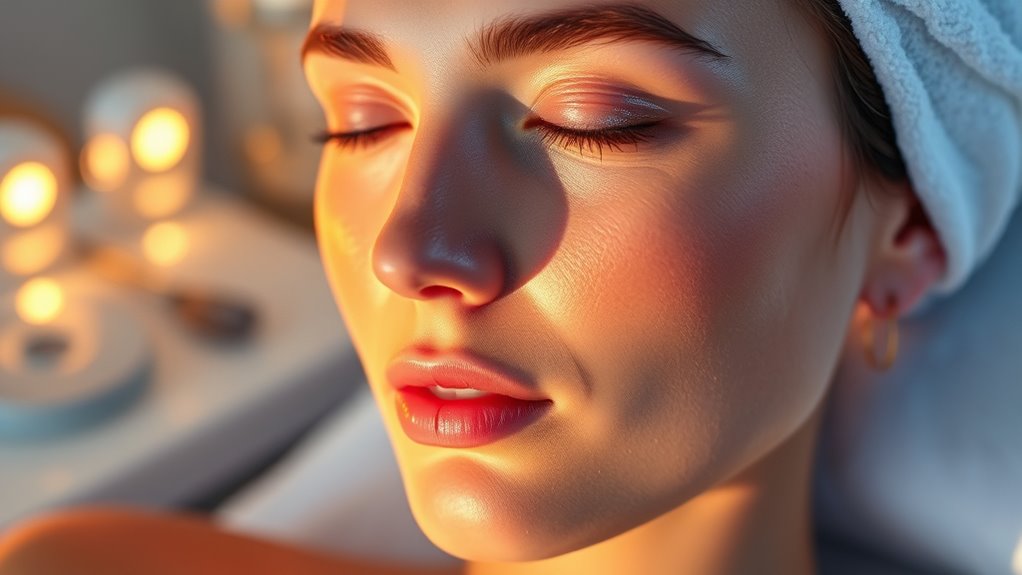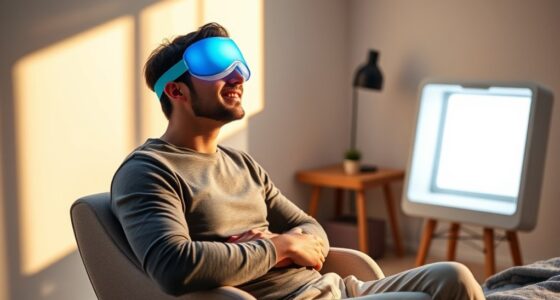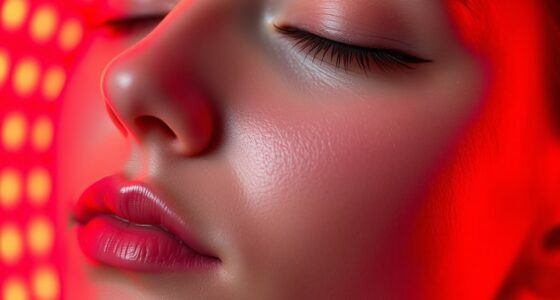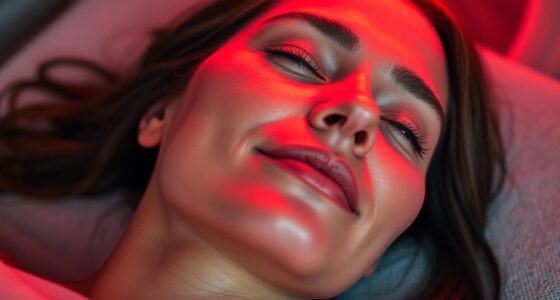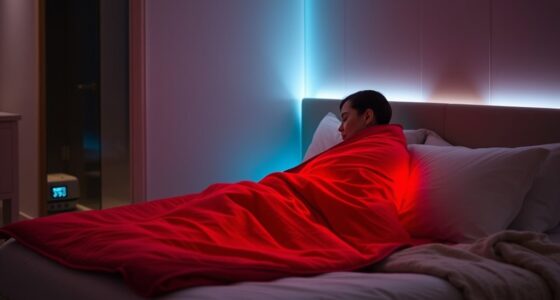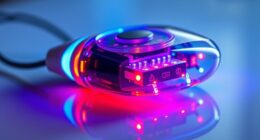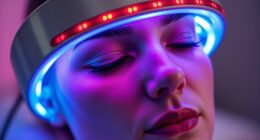Light therapy is a gentle, non-invasive way to improve post-acne marks. It uses specific wavelengths of light to stimulate your skin’s healing, boost collagen, and reduce discoloration. You can often try treatments at home or in clinics, with sessions lasting about 15-30 minutes. Since it’s safe and requires minimal downtime, it’s ideal if you want natural-looking results. Keep exploring to discover more tips on how to incorporate this effective strategy into your skincare routine.
Key Takeaways
- Light therapy uses gentle wavelengths to target discoloration and promote healing of post-acne marks safely.
- Blue and red light can reduce bacteria and boost collagen, improving skin tone with minimal discomfort.
- Regular, short sessions over several weeks enhance results without invasive procedures or downtime.
- Combining light therapy with consistent skincare and sun protection maximizes the gentle healing process.
- Ensure device quality and professional guidance to safely incorporate light therapy into your skincare routine.
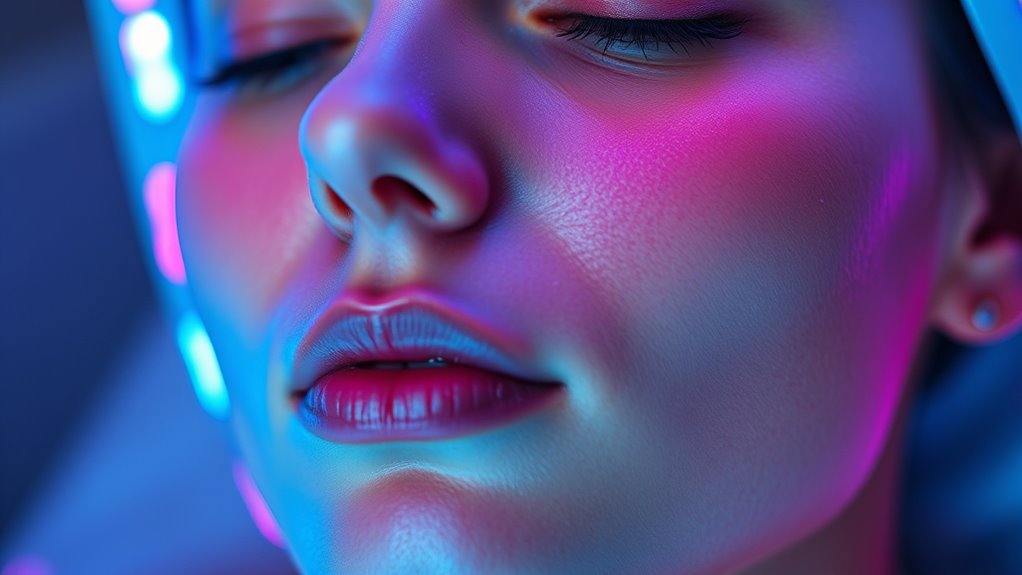
Are you looking for an effective way to reduce lingering post-acne marks? If so, light therapy might be worth considering. This innovative treatment uses specific wavelengths of light to target skin concerns, including discoloration and scarring caused by acne. Unlike more invasive procedures, light therapy offers a gentle approach that can fit into your skincare routine without much hassle. It’s a non-invasive method that’s gaining popularity for its safety and effectiveness, especially for those seeking a less aggressive way to improve their skin’s appearance.
Light therapy offers a gentle, non-invasive solution for reducing post-acne scars and discoloration effectively.
In essence, light therapy works by penetrating your skin with controlled wavelengths of light, stimulating cellular activity and promoting healing. Red light, in particular, is known for its ability to boost circulation and encourage collagen production, which can help fade scars and improve skin texture. Meanwhile, blue light is effective at targeting bacteria that contribute to acne, preventing future breakouts and helping your skin heal more efficiently. By combining these wavelengths, light therapy addresses both the existing marks and the underlying causes of acne, offering a thorough approach to skin rejuvenation.
One of the main advantages of light therapy is its gentle nature. You won’t need to undergo surgery or endure painful procedures; instead, you can receive treatments in a clinic or even use at-home devices designed for safe, everyday use. Sessions are typically quick, often lasting around 15 to 30 minutes, and don’t require downtime. This means you can easily fit treatments into your busy schedule, making it a practical choice for many. Plus, because the therapy is non-invasive, the risk of side effects is minimal, especially when administered by trained professionals or when using reputable devices.
Consistency is key with light therapy. To see noticeable improvements, you’ll need multiple sessions over several weeks. Patience and adherence to your treatment plan are essential, as results tend to develop gradually. You might start to notice a reduction in discoloration, smoother skin texture, and a more even skin tone as your skin responds to the treatment. It’s also important to pair light therapy with good skincare habits, like moisturizing regularly, wearing sunscreen, and avoiding picking at your skin, to maximize your results. Additionally, understanding the science behind light-based therapies can help you make more informed decisions about your skincare options.
Frequently Asked Questions
Is Light Therapy Suitable for All Skin Types?
Light therapy can be suitable for most skin types, but you should consult a dermatologist first. They’ll assess your skin’s unique needs and determine if this treatment is right for you. People with darker skin tones may need specific wavelengths to avoid pigmentation changes. Always follow professional advice, and start with a gentle approach to minimize risks. Proper guidance guarantees safe, effective results tailored to your skin type.
How Long Does It Take to See Results?
Seeing results from light therapy is like watching a sunrise—gradual but rewarding. Typically, you’ll notice improvements in your post-acne marks within 4 to 6 weeks of consistent treatments. Some people might see faster results, while others may need up to 12 weeks. Patience is key, and sticking to your treatment schedule maximizes your chances of achieving clearer, more even skin over time.
Are There Any Side Effects or Risks Involved?
Yes, there are some potential side effects and risks involved with light therapy. You might experience mild redness, dryness, or irritation after treatments, but these usually fade quickly. Rarely, you could encounter eye strain or discomfort. To minimize risks, follow your practitioner’s instructions carefully, wear protective eyewear, and avoid overexposure. If you notice persistent side effects, consult your healthcare provider promptly to guarantee safe and effective treatment.
Can Light Therapy Be Combined With Other Treatments?
Yes, you can combine light therapy with other treatments like topical creams or chemical peels. Make sure to consult your dermatologist to develop a safe, effective plan tailored to your skin. Combining treatments can enhance results, but it’s important to avoid overloading your skin and causing irritation. Always follow professional advice, and inform your provider about all treatments you’re using to ensure a coordinated approach.
How Often Should Sessions Be Scheduled for Best Results?
You should schedule light therapy sessions about two to three times a week for ideal results. Consistency is key, so stick to the recommended schedule provided by your dermatologist or skincare specialist. Avoid overdoing it, as more frequent sessions won’t necessarily speed up healing and could cause irritation. Usually, noticeable improvements appear after several weeks, so patience and adherence to your treatment plan will give you the best chance for success.
Conclusion
By incorporating light therapy into your skincare routine, you can considerably fade post-acne marks and regain your confidence. These gentle strategies are so effective, they might just transform your skin faster than you ever dreamed possible. Stick with consistent treatments, and you’ll soon see your scars diminish like magic—leaving you with a radiant, flawless complexion. Don’t wait—your glowing skin is just a light therapy session away from becoming a reality!
